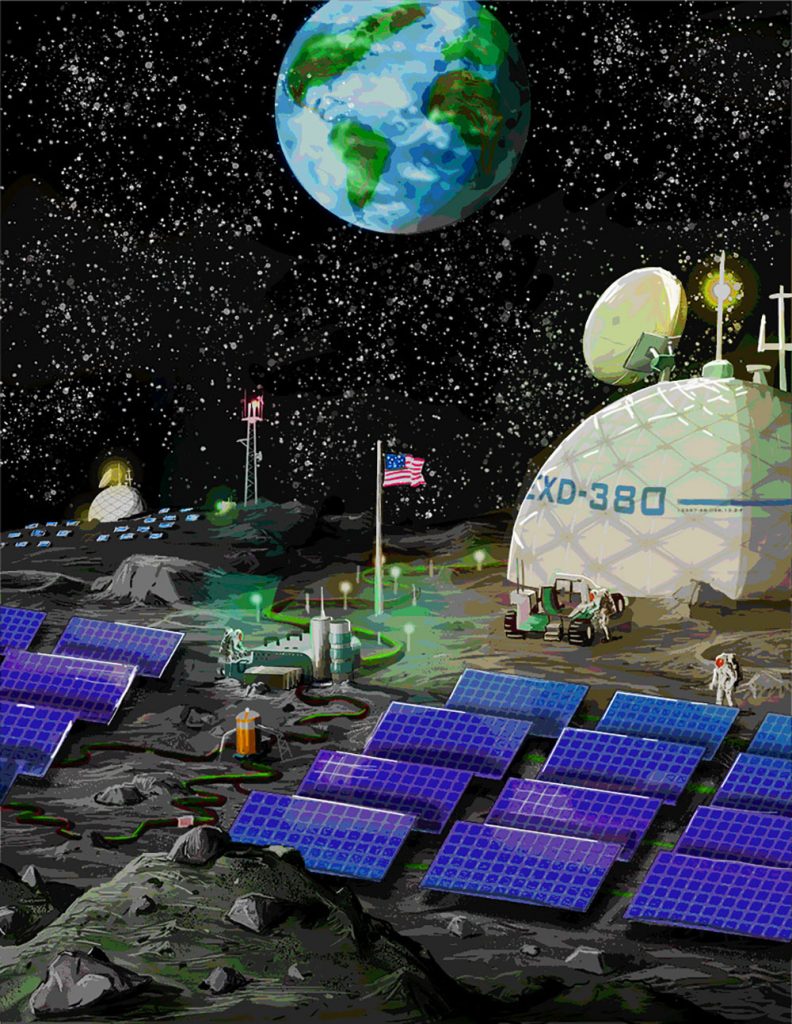To The Moon Alice! Sandia researchers design microgrid for future lunar base

Reliable, resilient microgrid to sustain astronauts, mining and fuel processing
Sandia is well known for designing reliable and resilient microgrids for military bases and vital city services. Now, Sandia researchers are working with NASA to design one for the moon.
This is not the first time Sandia has partnered with NASA to power equipment on the moon. In fact, Sandia provided the technical direction for the radioisotope thermoelectric generators that powered the lunar experiments placed by many of the Apollo missions.
NASA’s plan for its concept Artemis lunar base is that it will serve as a technology proving ground for the eventual human exploration of Mars, said Jack Flicker, a Sandia electrical engineer. The base camp concept consists of a habitation unit — complete with room for up to four astronauts — as well as the potential for separate mining and fuel processing, called in-situ resource utilization, facilities. Early Artemis missions will include short stays at the base camp with the goal to build up to stays of two months.
The mining and processing facilities could produce rocket fuel, water, oxygen and other materials needed for extended exploration of the lunar surface while decreasing supply needs from Earth. This facility will be located far away from the base camp — so other science and technology activities conducted there won’t be disrupted — but the electrical grid for the two units will be connected during emergencies for resiliency and robustness, Jack added.
One part of the Sandia team, which includes electrical engineer Lee Rashkin and control engineer Dave Wilson, is designing an electrical system controller for the mining and processing center’s microgrid. NASA is designing the electrical system controller for the habitation unit, as the system will be very similar to the International Space Station’s direct-current electrical system, Jack said. Jack and his part of the team are developing the system that will connect the two microgrids and are studying the power flow and operation between the two microgrids.
“There are some very important differences between something like an ISS-type microgrid to something that has the extent of a moon base,” Jack said. “One of those differences is the geographic size, which can be problematic, especially when running at low DC voltages. Another is that when you start to extend these systems, there will be a lot more power electronics as well as a lot more distributed energy resources that will exist throughout the base. Sandia has been looking at microgrids with a lot of distributed energy resources for quite a long time.”
Distributed energy resources are smaller sources of electricity such as solar panels and wind turbines, while power electronics are devices such as converters that keep electrical systems operating within specifications.
‘Cruise control’ for moon mining center electric system

Lee and Dave have been designing the software to regulate the electricity of the mining and processing center since early summer 2021. Dave compared their controller to the cruise control in a standard automobile in that it maintains an even voltage level on the grid, despite changing external situations.
The controller needs to be able to maintain an even voltage level on several different timescales, from less than a thousandth of a second to seasons. At the highest level of the control software, on the scale of minutes to seasons, people can control which solar panels generate power and what power-using devices are turned on, Dave said. However, at the lowest level, at less than a thousandth of a second, the controller needs to operate rapidly and automatically to maintain outputs at the required levels. They are primarily focused on the middle level of control, Lee said.
“Our goal is to come up with a lunar energy power management system that can efficiently maintain a level system on all those timescales,” Dave said. “We’ve got a specialized Secure Scalable Microgrid facility and control-system-design methodology that analyzes this. The facility also has specialized energy storage emulators that can help us determine the specifications for how much energy storage the base needs and their requirements.”
The Secure Scalable Microgrid Testbed is a unique Sandia research facility the team will use to fine-tune their control system. They will also use the testbed to study questions about power system controllers and the interactions between distributed energy resources, energy storage and power electronics on a DC microgrid that is a scaled and simplified representation of the eventual lunar microgrid, Lee said. Most terrestrial microgrids, and terrestrial electrical grids in general, run on alternating-current power.